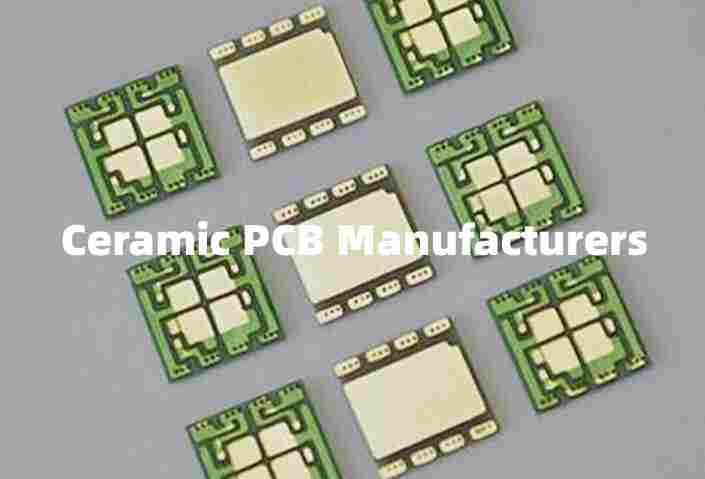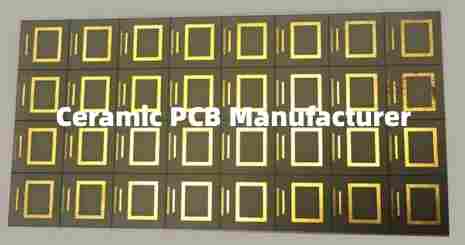In our ever-evolving electronics manufacturing landscape, innovation keeps pushing the boundaries of whatever is possible. The innovative advancement, which has been able to gain great momentum recently, is the sudden emergence of the ceramic PCB. This PCB type is a new type which has gained wide acceptance throughout the electronics world as a reliable and effective alternative.
Due to their great mechanical strength, thermal conductivity, as well as electrical insulation features, these ceramic PCBs are surely redefining possibilities for reliable and high-performance electronic systems. Here, we will be having an in-depth view of ceramic PCBs, giving an examination about their unique features, different applications, types, etc.
What are Ceramic PCBs?
Ceramic PCBs deviate or dissociate from the traditional use of epoxy resin or fiberglass by using ceramic material as its substrate or base. This PCB includes an insulating and thin layer made up of a ceramic material that is integrated with different metal components so as to help in establishing the circuitry. This ceramic base material utilized in the ceramic PCBs like aluminum nitride, alumina, and beryllium oxide has great capabilities for heat conduction.
Due to its enhanced performance and great thermal abilities, the ceramic PCB serves as a great option for traditional PCBs found in several applications like LEDs, solar panel arrays, memory modules, multilayer interconnect boards, telecom devices, etc.
The most prominent of all the features of the ceramic PCB are its resistance to high temperature as well as its great electrical insulation. Also significant are other benefits such as its low dielectric loss and dielectric constant, great chemical stability, high thermal conductivity etc.
Ceramic PCB Types

High-temperature ceramic PCBs
People really love working with ceramic PCBs of high temperatures. This is because they have what it takes to withstand as well as function in any high-temperature environment. These PCBs are referred to as the HTCC circuits or high temperature co-fired ceramic circuits. Also, HTCC PCBs are made from raw materials that are mixed with adhesives, solvents, lubricants, aluminum oxide, as well as plasticizers.
Low Temperature Ceramic PCBs
Low temperature co-fired ceramic PCBs provide special benefits compared to the remaining ceramic PCB types. In contrast to the HTCC, the manufacturing of these PCBs are done through the combination of crystal glass with adhesive substrates present on a sheet metal that makes use of gold paste. Then, the circuit board that results is cut, laminated, and then placed in the gaseous oven at a temperature of about 900 degrees.
One important benefit of the LTCC PCB is their better shrink tolerance as well as reduced warpage when drawn in comparison with HTCC as well as other types of ceramic circuit boards. Also,. This will translate into an enhanced thermal conductivity and mechanical strength.
Particularly, LTCC PCBs are beneficial for applications that involve heat dissipation products because they provide better thermal advantages.
Thick film Ceramic PCBs
This type of ceramic PCBs features a conductor layer that can possess a thickness surpassing 10 microns. However, it doesn’t surpass 13 microns. For the ceramic PCBs, they have an adorned surface with a layer conductor which is imprinted meticulously making use of precious metals such as gold or silver. This deals with the application of dielectric or gold plates on ceramic base materials, which is followed by the baking process within a temperature less than 1000 degrees Celsius.
Using this type of ceramic PCB is popular among many PCB manufacturers because of their extremely low cost for gold conductor pastes. Furthermore, another benefit of this ceramic PCB type over the traditional printed circuit boards has to do with their capability to protect the copper from any possible oxidation.
In addition, this feature permits the manufacturers of ceramic PCBs to integrate interchangeable semiconductors, conductors, resistors, and capacitors on a ceramic board.
Best 5 Ceramic PCB Manufacturers

RayMing PCB
RayPCB provides ceramic PCBs to suit your circuit board needs. A good number of PCBs see that ceramic boards come with greater benefits compared to the traditional boards that are manufactured from other materials. Also, they offer suitable substrates that are designed for different electronic circuits having high thermal conductivity coupled with a low CTE or thermal expansion coefficient.
Multilayer ceramic PCBs are very versatile and have what it takes to replace the traditional PCB completely even with an increased performance and less complicated designs. Also, they can be utilized for proximity sensors, chip-on-board modules, high-power circuits, etc.
Asides from its great expansion coefficient and thermal properties, the ceramic boards function at a temperature of about 350 degrees Celsius, thereby creating smaller package sizes, and providing great high-frequency performance.
Making use of ceramic PCBs could also lead to a reduced system cost overall and become very cost-effective for the dense packages because of the presence of processing layers. RayPCB is surely one of the best.
Hillman Curtis
Regarding ceramic PCB manufacturing, choosing the best manufacturer is very important. An experienced and a reliable manufacturer will make sure of the best precision, quality, as well as performance of the ceramic PCBs. Having been committed to excellence and years of professionalism, this company has become a reliable solution for the manufacturing of ceramic PCBs.
Hillman Curtis makes use of cutting edge facilities as well as manufacturing processes as well as performs strict measures for quality control to ensure the manufacturing of high-quality ceramic PCBs. This company has a good understanding of the ceramic circuit board and will give customized solutions, which meets the highest standards of the industry.
Alumina PCB
This is another top-notch ceramic PCB manufacturer that you might want to reach out to when the design is set and ready. Alumina PCB promises to deliver the best service possible, most especially with delivering the greatest thermal efficiency for the ceramic PCB devices of high performance.
Also, the manufacturer works with the industry standards, which includes making sure circuit boards will meet the UL, IPC, and RoHS requirements. In addition, this company provides extra services related to ceramic PCB manufacturing, which ranges from its fabrication to its assembly.
Furthermore, Alumina PCB boasts a dedicated engineering team that is professionals in every aspect of the ceramic PCB designing, manufacturing, as well as the assembly and the testing. The company also utilizes advanced processes and equipment to make sure their printed circuit boards meet high-quality standards required.
4PCB.com
The company has more than a decade of experience in the manufacturing of different ceramic PCBs. These include the sensor ceramic PCBs. This company promises to give affordable or competitive pricing, to assist you in acquiring the required number of ceramic PCBs.
The different ceramic PCBs manufactured by 4PCB can be utilized in several industries. Take for example, the new energy car type of ceramic PCBs is appropriate for integrated circuits and high-power devices that require heat dissipation material as well as a semiconductor module circuit. Also, this company produces the sensor ceramic PCB. This is appropriate for any application that requires the piezoelectric effect.
NextPCB.com

This company deals with the manufacturing of Alumina Substrate and Alumina Nitride ceramic PCBs. The manufacturing of these boards are usually done with utmost care, as well as with consideration for specific use cases and applications.
Next PCB promises a build or lead time of 4 weeks and integrates about 4 layers inside the circuit board. Also, NextPCB applies a board thickness that falls between 0.25 mm to 0.2 mm for the ceramic PCBs.
Different applications for their ceramic PCBs include automotive sensors, refrigeration sheets, as well as electronic modules of high power. This company is a top provider of PCB assembly and prototyping services. NextPCB.com has been in this business for the past 15 years and boasts a proven record of offering high-quality PCBs as well as PCB assembly and at very competitive prices.
Also, NextPCB.com is certified by UL, ISO, IATF, REACH, and ROHS which makes sure that your printed circuit boards are safe and they comply with all regulations applicable.
Things to Consider when Choosing a Ceramic PCB Manufacturer
Manufacturing processes
This ceramic PCB manufacturing process is very significant for targeted applications. Therefore, choose a manufacturer that works with the right manufacturing processes
Consider the use cases and applications
Depending on the capabilities of the ceramic PCB manufacturer, the circuit board manufacturer might differ. This is why you may wish to verify the supported devices or applications that your ceramic PCB can be utilized for.
Check the Material’s Quality
Ceramic PCB manufacturers have to be able to reveal the material he or she is using for the manufacturing process of the ceramic POCB. Ensure it has great quality.
Conclusion
In summary, ceramic PCBs deviate or dissociate from the traditional use of epoxy resin or fiberglass by using ceramic material as its substrate or base. This PCB includes an insulating and thin layer made up of a ceramic material that is integrated with different metal components. Due to their great mechanical strength, thermal conductivity, as well as electrical insulation features, these ceramic PCBs are surely redefining possibilities for reliable and high-performance electronic systems.






Leave a Reply